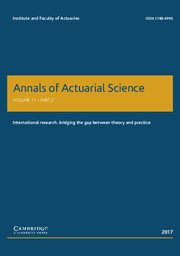Article contents
Modelling the liquidity premium on corporate bonds
Published online by Cambridge University Press: 16 February 2015
Abstract
The liquidity premium on corporate bonds has been high on the agenda of Solvency regulators owing to its potential relationship to an additional discount factor on long-dated insurance liabilities. We analyse components of the credit spread as a function of standard bond characteristics during 2003–2014 on a daily basis by regression analyses, after introducing a new liquidity proxy. We derive daily distributions of illiquidity contributions to the credit spread at the individual bond level and find that liquidity premia were close to zero just before the financial crisis. We observe the time-varying nature of liquidity premia as well as a widening in the daily distribution in the years after the credit crunch. We find evidence to support higher liquidity premia, on average, on bonds of lower credit quality. The evolution of model parameters is economically intuitive and brings additional insight into investors’ behaviour. The frequent and bond-level estimation of liquidity premia, combined with few data restrictions makes the approach suitable for ALM modelling, especially when future work is directed towards arriving at forward-looking estimates at both the aggregate and bond-specific level.
- Type
- Papers
- Information
- Copyright
- © Institute and Faculty of Actuaries 2015
References
- 2
- Cited by


